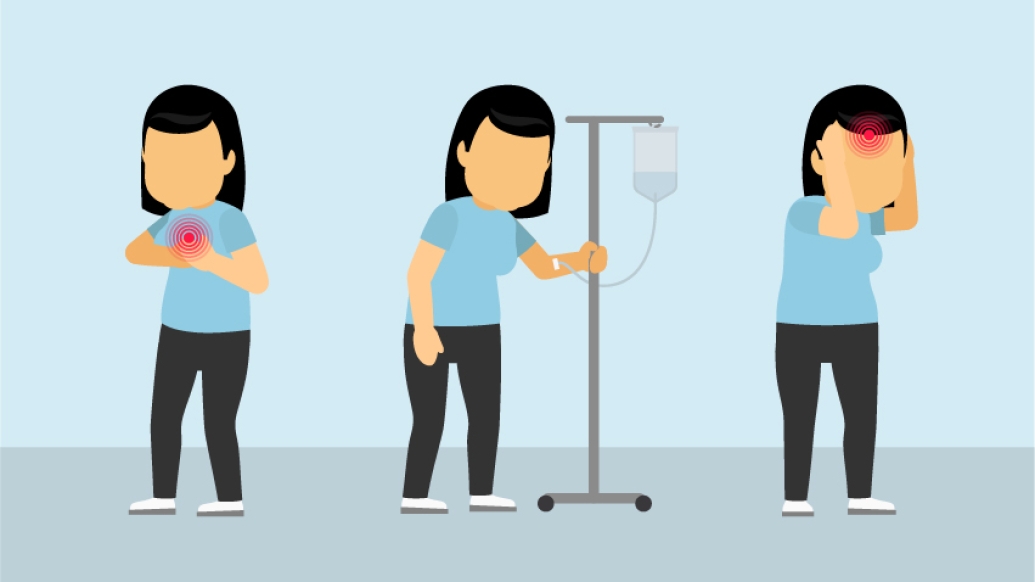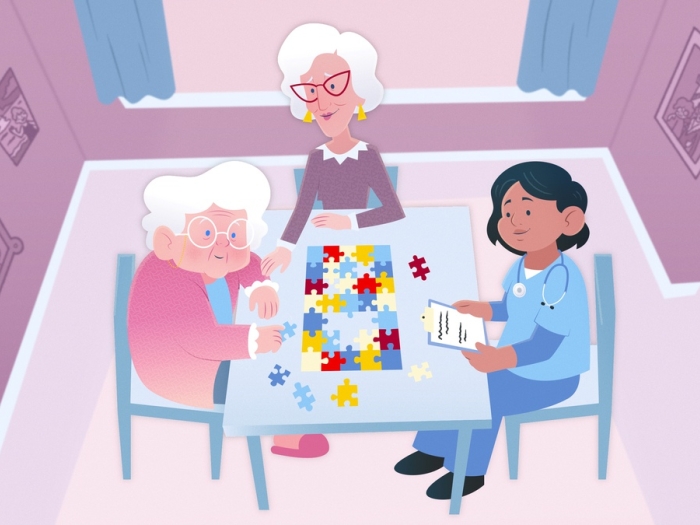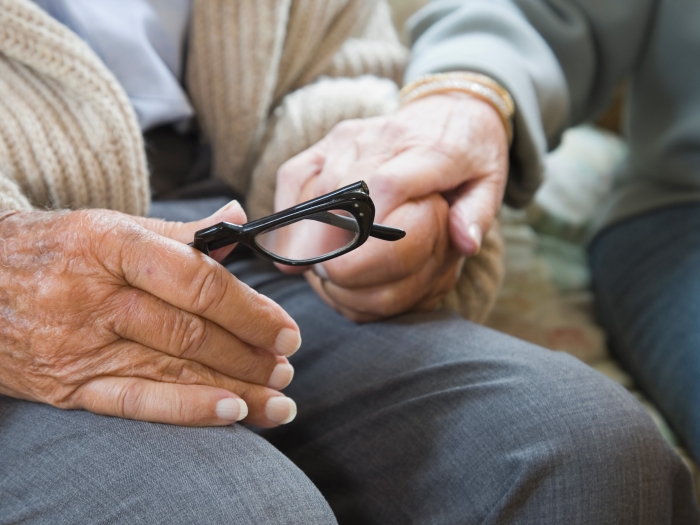A new tool “scores” patients based on the impact of their multiple chronic conditions. The tool reveals that those with higher scores have faster memory loss, a higher suicide risk and a higher overall risk of death.
10:00 AM
Author |

Having arthritis, diabetes or heart disease can change a person's life — getting in the way of daily activities and sometimes requiring special diets and medications.
But what happens when new conditions are stacked on top of old ones, creating a burden of multiple diseases that need daily managing?
LISTEN UP: Add the new Michigan Medicine News Break to your Alexa-enabled device, or subscribe to our daily audio updates on iTunes, Google Play and Stitcher.
Multimorbidity has several downstream consequences. Physical impairments are just the beginning.Melissa Wei, M.D., MPH, M.S.
As millions of Americans cope with a combination of medical conditions, a new approach to measuring their lives has emerged.
Multimorbidity scores can help doctors understand a patient's overall prognosis — and can help researchers identify special risks faced by people with multiple chronic illnesses.
In fact, new research by a University of Michigan team shows that people with higher multimorbidity scores had a much faster decline in their thinking and memory abilities than those with lower scores.
SEE ALSO: Use of Risky Brain-Affecting Drug Combinations Rising Among Seniors
Even though most of the chronic conditions included in the index have no direct relationship with brain health, the higher a person's score, the faster they declined over a 14-year period in their ability to recall words and do simple math.
The results, published online in The Journals of Gerontology: Series A, used data from more than 14,265 people studied multiple times over a decade or more through the Health and Retirement Study based at U-M.
Meanwhile, the same index recently revealed that people with higher scores were more than twice as likely to die by suicide than those with lower scores, and that they suffered from poorer overall mental health.
MORE FROM MICHIGAN: Sign up for our weekly newsletter
Those findings — made by calculating the multimorbidity index for participants in three long-term studies of more than 250,000 health professionals including dentists, podiatrists, chiropractors and nurses — were published in the Journal of the American Geriatrics Society and featured on the GeriPal podcast. They show the mental and physical burden of living with multiple diseases.
U-M researcher and Michigan Medicine primary care physician Melissa Wei, M.D., MPH, M.S., spearheaded the development of the scoring system, called the multimorbidity-weighted index, or MWI.
Assessing the impact of a person's health conditions is important because 45 percent of all adults have more than one condition — and that figure jumps to 80 percent after age 65, Wei says.
Careful tool development
Over years, Wei compiled and tested a way to assess what life is like for people with multiple chronic conditions, from glaucoma and heart arrhythmias to multiple sclerosis and a history of knee, hip and spinal disk problems.
But it's not as simple as counting the number of diseases and conditions a person has been diagnosed with, the researchers caution.
Rather, the risk of cognitive decline, suicide or poor mental well-being has to do with the total impact of a person's unique combination of conditions on his or her quality of life.
Because different conditions affect people in different ways, the scoring system takes into account how that happens — and how those effects might interact with one another.
Early this year, Wei and colleagues published a study showing that the risk of dying rose 8 percent for every single-point rise in MWI score, and that the rise in score tracked closely with the decrease in physical abilities of people with multiple conditions.
That study, also in The Journals of Gerontology: Series A, also used Health and Retirement Study data, from 18,174 people ages 51 and older who took part in the study over 11 years.
How to calculate a multimorbidity score
While the MWI scoring approach has been useful in research, Wei and her colleagues now hope that clinicians can use it to help them understand the needs and manage the care of patients with multiple conditions.
A free MWI scoring tool is now available for clinician use at the website ePrognosis, run by the University of California, San Francisco.
Any clinician can enter a few pieces of anonymous information about patients over age 54 into the calculator and come up with a score for them.
The results page also gives a breakdown of how likely people like that study participant are to die within the next 10 years or to experience a decline in their physical functioning in the next four to eight years.
While Wei cautions clinicians not to use the score as the sole indicator of a patient's prognosis, she hopes the score can help guide discussions about a range of decisions, including preventive care, elective surgery, living arrangements and end-of-life care preferences.
Using multimorbidity research
The research that Wei and colleagues have done on the impact of high MWI scores across groups of patients could also help guide care.
For instance, the finding that suicide risk rose sharply as MWI score rose could help clinicians think about which patients might be most in need of depression and suicide screening.
As patients develop more conditions with age, physicians may want to monitor their mental health more closely and offer appropriate lifestyle advice and treatment.
"As clinicians, we are more likely to assess suicide risk in people with known depression or other mental health or substance use issues, but we may not automatically consider that those with more physical conditions only could also be at higher risk," Wei says.
"Multimorbidity has several downstream consequences. Physical impairments are just the beginning," she says. "As conditions accumulate and physical functioning deteriorates, we have found this is closely linked to worse mental health, social health and eventually premature mortality."
In short, Wei says, "the association between the MWI score with suicide risk and overall mental well-being warrants attention."
Functionally older
Having a high MWI score, she says, makes someone functionally older than their calendar or "chronologic age" would suggest.
Clinicians can use the score to help them think about the "biologic age" of the patient before them based on the life span expectations for people with similar scores.
Using scores clinically could also help providers ensure that patients with high scores receive care management services or other support to help them live their best lives and keep on top of the tests, treatments and lifestyle changes that can help them do so.
"We want patients to have good insight into how the conditions they've developed over the years are affecting their well-being and be open to communicating with their care teams about how those conditions affect their functioning, quality of life and overall health now and in the future," Wei says.
"We also know that social support and having a strong purpose in life can protect against some of the detrimental effects of multiple conditions," she says. "We need to help patients understand these connections, foster their development early on and sustain them through each stage of life and changes in health."
Wei's research and the development of the MWI tool are funded by the National Institute on Aging of the National Institutes of Health, as are the large studies that provided the data used to validate the tool and discover the impact of high MWI scores.

Explore a variety of healthcare news & stories by visiting the Health Lab home page for more articles.

Department of Communication at Michigan Medicine
Want top health & research news weekly? Sign up for Health Lab’s newsletters today!





